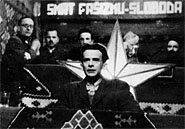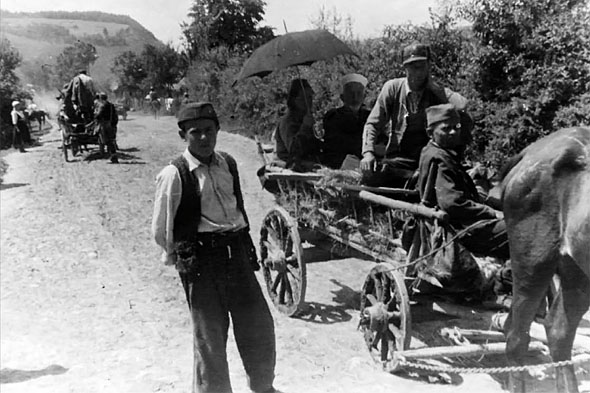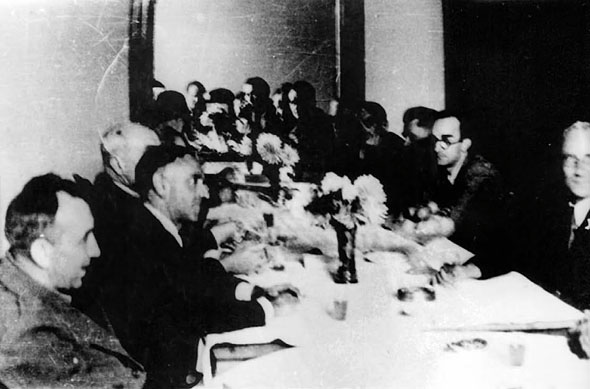History of Parliamentarism in BiH
World War II and the establishment of the National Anti-Fascist Council of the People’s Liberation of Bosnia and Herzegovina
After the attack by Nazi Germany against the Kingdom of Yugoslavia and the April blitzkrieg, the Yugoslav country collapsed and signed an unconditional capitulation on April 17, 1941.
(Monographs of the "Parliamentary Assembly of Bosnia and Herzegovina, the 2010 edition.)

The Independent State of Croatia, which also comprised Bosnia and Herzegovina, was proclaimed on April 10, 1941. By the legal provision of June 10, 1941, the territory of the Independent State of Croatia was split into 22 administrative units – large districts which were further split into counties and counties into municipalities. By including large parts of Bosnia and Herzegovina in vast districts, the centers of which were located in Croatia, an attempt was made to form a single state territory for the Independent State of Croatia. Conflicts broke out, with growing indignation and resistance to the fascist occupation. For this reason the Communist Party of Yugoslavia’s concept of the anti-fascist fight, based on the joint struggle of all peoples of Yugoslavia against the fascist occupier and numerous local collaboration structures, enjoyed ever increasing reputation and had mobilizing power.
Parallel to the anti-fascist fight, the Communist Party of Yugoslavia also carried out revolutionary changes in power. The basic factors in the destruction of the old social and political system and in building a new system of authority were people’s-liberation boards and anti-fascist councils of the people’s liberation. The process of setting up the partisan authorities in Bosnia and Herzegovina concurred with the strengthening of the people’s-liberation movement from the time of the uprising (July 1941), and continued through the establishment of the Anti-Fascist Council of the People’s Liberation of Yugoslavia (orig. abbrev. AVNOJ) and the National Anti-Fascist Council of the People’s Liberation of Bosnia and Herzegovina (orig. abbrev. ZAVNOBiH), culminating in the liberation of the country and legalization of an established structure of authority. As territories were taken by partisans, local authorities were set up, marking the beginning of the new state authorities.
Within the organization of the people’s-liberation movement, Bosnia and Herzegovina was split into three regions: Bosnian Krajina, East Bosnia and Herzegovina. Decisions on the appointment of the first members of the national boards were rendered by the staffs and the party organizations of the partisan detachments, which citizens accepted at the meetings – members of the national boards were not elected.

Arrival of the participants at the First Session of the ZAVNOBiH
Although the national boards had already been established, the Foča Regulations titled “Tasks and organization of the people’s-liberation boards and explanations and directives for the activities of the people’s-liberation boards in the liberated areas” of February 1942 stipulated the fundamental principles of the organization and functioning of the people’s-liberation boards, their elections, revocation as well as other issues. The new partisan authorities were set up by the appointment of various acting officers, not by election but by acclamation. The Foča Regulations also secured the foundation of the new election system which, apart from indirect election, also introduced the delegate system of election of high authorities, and confirmed the women’s right to vote. Universal suffrage was introduced and voting was open. The issues of election boards, members of election boards and voters’ meetings were regulated. The people’s-liberation boards functioned in the free territories during the partisan units’ control over certain territories and, if they were occupied by the enemy, their activities ceased until the next opportunity.
In order to establish the structure of the new authorities, national authorities needed to be in place. Numerous rural, municipal, county, district and regional people’s-liberation boards would have excessively burdened the Supreme Staff of the people’s-liberation movement, which was predominantly in charge of military operations. Therefore, it was necessary to establish a central body of the national authorities to take over from the Supreme Staff the civil administration of liberated territories. Thus, the first session of the Anti-Fascist Council of the People’s Liberation of Yugoslavia (orig. abbrev. AVNOJ), the highest political representative body of the people’s-liberation movement of Yugoslavia, was convened in Bihać on November 26, 1942. The AVNOJ elected its executive board which, together with the Supreme Staff, constituted the state structure of authorities at the level of Yugoslavia as a whole. In spite of the fact that the war continued to rage unabated, the Executive Board rendered a decision to convene a session of the National Anti-Fascist Council.
Due to the principle of so many ethnicities, so many federal units, there arose different views about the establishment of Bosnia and Herzegovina as a federal unit. Some party leaders believed that Bosnia and Herzegovina could not be a separate federal unit considering its multi-ethnicity, and that it should be made an autonomous province of Serbia or Croatia, or linked to the federative authorities of the new Yugoslavia. This was opposed by the leadership of the Regional Committee of the Communist Party of Yugoslavia for Bosnia and Herzegovina (orig. abbrev. (PKKPJ za BiH). The prominent revolutionaries Avdo Humo, Rodoljub Čolaković, Hasan Brkić, as well as others, requested Josip Broz Tito and Edvard Kardelj that Bosnia and Herzegovina have equal status within the Yugoslav federation. They succeeded in their efforts by reasoning their request along historical lines. Their request also included permission for convening a national conference for Bosnia and Herzegovina. Through the Party channels, the Regional Committee of the CPY for Bosnia and Herzegovina,, with the consent of the Central Committee of the CPY, asked the county and regional boards to forward their lists of candidates for the first national representative body. Those included AVNOJ attendees from the territory of Bosnia and Herzegovina, partisan unit veterans, prominent military commanders, political commissars, all of the members of the regional national boards and five prominent political, public and cultural figures from every county, and people who were sympathizers with the partisan movement and uncompromised with regard to the enemy. The social structure of the participants varied, while the ethnic composition was harmonized with the ethnic structure of the people’s-liberation movement. The majority of ZAVNOBiH delegates were elected based on the Communist Party’s directives and instructions through military and party organizations and the bodies of the national government. As the lower levels of authority were also elected upon the same principle, this form of political representation may be defined as wartime partisan-party parliamentarism. Further spreading from the nucleus of the people’s boards resulted in the setting up of a hierarchical network of people’s boards which, by virtue of representation at the level of Bosnia and Herzegovina, made the ZAVNOBiH its highest political representative body.
The First Session of ZAVNOBiH, as the highest political representative body of Bosnia and Herzegovina, was held in Mrkonjić Grad November 25-26, 1943, during which 173 councillors, 31 members of the Presidium and five members of the Presidency of the Presidium of ZAVNOBiH were elected. The following persons were elected to the Presidium Presidency: dr. Vojislav Kecmanović, President, Avdo Humo, first Vice-President, Aleksandar Preka, second Vice-President, Đuro Pucar Stari, third Vice-President, and Hasan Brkić, Secretary. According to the ZAVNOBiH Resolution, Bosnia and Herzegovina was proclaimed a federal unit of equal peoples. 58 councillors and their 46 deputies were elected for the Second Session of AVNOJ where, on November 29, 1943, they represented Bosnia and Herzegovina in Jajce, and at which the structure of the new state with six federal units and five peoples, which did not include Muslims, was confirmed. Although during the war the names of the most numerous peoples in Bosnia and Herzegovina, Serbs, Croats and Muslims, were used in communication, manifestos and official documents on an equal footing, an adequate place for Muslims in terms of ethnicity was not recognized. According to the decisions of the Second Session of the AVNOJ, the foundation of the federative system of the Democratic Federative Yugoslavia was established. The National Anti-Fascist Councils were constituted into the highest legislative and executive representative bodies and were entitled to set up the people’s governments as executive bodies.

The Second Session of the ZAVNOBiH
The Second Session of the ZAVNOBiH was held in Sanski Most from June 30 to July 2, 1944, and was attended by 107 councillors of the 148 who filed their credentials. It was also attended by the members of the allied military missions from the Soviet Union, Great Britain and the United States of America, and ZAVNOH representatives, while the AVNOJ representatives were prevented from coming from the island of Vis due to combat activities. At its Second Session, the ZAVNOBIH was constituted into the highest legislative authority in Bosnia and Herzegovina, the People’s Assembly, as the bearer of people’s sovereignty. A Declaration on the rights of the citizens of Bosnia and Herzegovina was issued at the session of July 1, 1944, which states, inter alia: “From the fire of the just liberation war, the fraternity of Serbs, Muslims and Croats is being forged, thus laying the strong foundations of a free and brotherly Bosnia and Herzegovina, an equal federal unit of Democratic Federal Yugoslavia.” Apart from the principle of the equality of peoples, the provisions of the Declaration on human rights and freedoms, which are consistent with modern European standards, should also be noted. The ZAVNOBiH Declaration on the rights of people in Bosnia and Herzegovina guarantees freedom of worship, freedom of assembly, agreement and association, freedom of the press, security of citizens’ personal property, freedom of private initiative in the economic sphere, and the equality of women and men, as well as the right to a trial before sentencing. Unfortunately, immediately after the liberation, a part of the proclaimed principles by which human and civil rights and freedoms were guaranteed was abandoned.
In response to the circumstances of the war, the ZAVNOBiH merged its legislative and executive powers, and all of its organs were named “the people’s,” implying that people directly participated in managing all state affairs through this representative body. The ZAVNOBiH Presidency exercised total power until the establishment of the government; therefore, the necessary number of departments was set up within it to deal with state administration affairs, marking the inception of the future Ministers. At the sessions of the Presidency from July 6, 1944 to February 7, 1945, the following departments were established: the people’s economy, people’s education, people’s health and social welfare, people’s reconstruction, the judicial system, nutrition, finance, and interior affairs. They introduced the people’s liberation assemblies at the state level, while their boards were the executive authorities. The right to vote for men and women as of the age of 18 was regulated, and the categories of the population that were deprived of that right were also indicated. The Rules of Procedure for the ZAVNOBiH and all lower levels of authority were regulated by special decisions. The fact that the new government was fully established is manifest in the adopted decision on forming the National Commission for the Investigation of the Occupier’s Crimes, and for gathering information on war damage, in coordination with the State Commission formed within the National Committee for the Liberation of Yugoslavia (NKOJ), which functioned as the Yugoslav government. The ZAVNOBiH Presidium consisted of the Presidency, which comprised the President, three Vice-Presidents, a Secretary and 22 members.
The Party believed that it needed a wide base for its activities and, immediately after the Second Session of the ZAVNOBiH on July 3, 1944, it convened in Zdena near Sanski Most the First National Conference of the People’s Liberation Movement of Bosnia and Herzegovina, at which the People’s Liberation Front was established, being the widest transmission of the revolutionary fight in the period of the transition of power. In the presence of 150 delegates from throughout Bosnia and Herzegovina, the legitimacy of the creation of a political organization comprising the majority of the population was secured. Through the People’s Front Organizations, it was possible to spread ideas, implement various measures and decisions, control the population and apply certain sanctions against those who did not accept the new government.
The administrative apparatus of the ZAVNOBiH was built up through planned activities. The established departments were managed by the Presidency members, thus performing the duties of the government of Bosnia and Herzegovina, which could not be established officially at that time, but which was done soon after the liberation of the country.
During the war, the partisan movement in Bosnia and Herzegovina created a government parallel to the official one, and managed to prepare strong foundations for the legalization of revolutionary power prior to the country’s liberation. Thus, from a party that was only active underground, the Communist Party of Yugoslavia became a leader in setting up a one-party political system with total control over society. In a Yugoslavia renewed on quite different grounds, Bosnia and Herzegovina found its place as one of six federal units, whose further development was directly subordinated to the federative organs in Belgrade.

